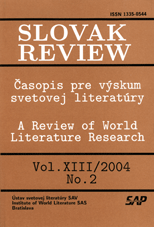KONTEXTUALIZÁCIA LITERÁRNEHO DIELA. (K postaveniu antropologického výskumu osobnosti a diela)
Contextualization of a Literary Work
Author(s): Mária BátorováSubject(s): Literary Texts
Published by: Ústav svetovej literatúry, Slovenská akadémia vied
Keywords: Modernism in Literature; Comparation; Interdisciplinary Approach; Structure of Meaning in a Literary Work; Anthropological and Psychological Aspect; Deconstructive Comparative Method.
Summary/Abstract: The research on contextualization of a literary work deals primarily with new reading of home and selected world literature, i. e. reading after the year 1989, when the conditions for free thought were favourable. Eventual interpretations put emphasis on inner-meaning structure of literary works and include also their anthropological and psychological aspect. The interdisciplinary view is an important issue in all the process of research. Thus the proposed method of contextualization starts with the literary work itself, moving the attention to the category of author, his individual perception of the world and reality and finally to the milieu or society where the author lives and writes his works. This is connected with the following reception of the work of art or with its absence, as well as with its influence. In the middle of the nineties there was an important work in Slovak Slavistic theory, Theory of Interliterary Process (1995) by I. Ďurišin, which offers a compact conception of inerliterary research, determined by the systematic interliterary studies. Ďurišin 's works, with their open and sophisticated formulations, create conditions for unique, self-reliant and subjective approach to a specific field of research. This is legitimized by the substantial published material and many cited works of secondary literature. Of all Ďurišin 's work the most instructive for our research is the category of typological context, which is viewed by the theorist as the basis of interliterary process. In our approach to the work of art and its contextualization the proposed method consists of the research of particular authors and their works in their particular literatures, meanwhile the method of D. Ďurišin focuses on macro-structures and theoretical interliterary relations. He choice of authors is not coincidental, for they are part of theoretical paradigm of modernism. He basic unit of analysis is thus the work of art and its creator. This analysis results in meanings, topics, motives, and adaptations on the basis of which the work of art is contextualized and which create the network of relations in the field of possibilities. A good example of this is a particular phenomenon, a writer, painter and businessman Hronsky, who represents a complex of relations (the anthropological and psychological aspect), topics (the existential issues from the beginning of the 20th century), and techniques (self-reflection, lyrization). The time scope of the research is the period of classic modern, a concept that arose in fields of research different than the literary science, which makes the modern plausible to be a subject matter of these. This methodological approach may be legitimized by the simple fact that the modern as a newromantic style is anchored in human identity as an individual creative subject.
Journal: Slovak Review of World Literature Research
- Issue Year: 2004
- Issue No: 02
- Page Range: 132-143
- Page Count: 12
- Language: Slovak

